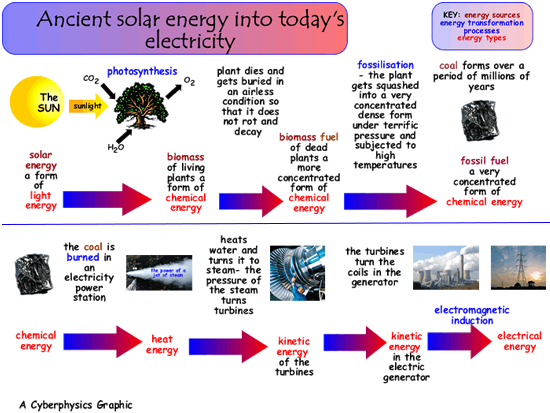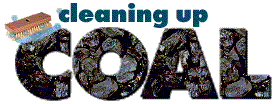Coal Coal is a fossil fuel. It is a non-renewable energy resource. It is a hard, black colored rock-like substance. It is made up of carbon, hydrogen, oxygen, nitrogen and varying amounts of sulphur.
In the centuries since early man learned the pieces of black rock he picked up on the ground would burn well and make long lasting fire, we have had to look for coal beyond the places where we could find it on the ground. One of the areas it was easiest to find was where it appeared as one of many layers of materials along the side of a hill. Then he found we could follow the coal layer (seam) deeper and deeper into the ground. Today we 'mine' coal - miles underground! Mining is classified by the method needed to reach the coal seam. When the coal is found close to the Earth's crust and taking away the overlying layers of material is not too expensive, surface mining is used to remove the top layers of materials and expose the coal. Underground mining has to be employed if coal is found in layers deep under the surface. Vertical or slanted "shafts" are cut down to the mining area underground for ventilation for the workers and for transporting the miners, equipment, and coal. Common types of underground mining are the drift, shaft, and slope mining methods. In the mine, coal is loaded in small coal cars or on conveyor belts which carry it outside the mine to where the larger chunks of coal are loaded into trucks that take it to be crushed (smaller pieces of coal are easier to ship, clean, burn, etc.). The crushed coal can then be sent by truck, ship, railroad, or barge. You may be surprised to know that coal can also be shipped by pipeline. Crushed coal can be mixed with oil or water (the mixture is called a slurry) and sent by pipeline to an industrial user. Classifications of Coal TypeThe material that formed the fossil fuel coal varied greatly over time as each layer was buried. As a result of these variations and the length of time the coal was forming, several types of coal were created. Depending upon its composition, each type of coal burns differently and releases different types of emissions. The four types (or "ranks") of coal mined today are: anthracite, bituminous, subbituminous, and lignite.
The precursor to coal - peat - is still found in many countries and is also used as an energy source. Pollution ProblemsTrapped inside coal are traces of impurities like sulfur and nitrogen. When coal burns, these impurities are released into the air. While floating in the air, these substances can combine with water vapour and form droplets that fall to earth as dilute forms of sulphuric and nitric acid – acid rain. There are also tiny specks of minerals – including common dirt – mixed in coal. These tiny particles don't burn and make up the ash left behind in a coal combustor. Some of the tiny particles also get caught up in the swirling combustion gases and, along with water vapour, form the smoke that comes out of a coal plant's smokestack. Some of these particles are so small that 30 of them laid side-by-side would barely equal the width of a human hair! they not only make the air dirty but also settle in the lungs of people and animals and cause breathing difficulties and respiritory diseases. Coal like all fossil fuels is formed out of carbon. All living things - even people - are made up of carbon. (Remember - coal started out as living plants.) So when coal burns, its carbon combines with oxygen in the air and forms carbon dioxide. Carbon dioxide is a colourless, odourless gas, that makes up 0.04% of the atmosphere. It is one of several gases that are responsible for the Greenhouse Effect.
|
Follow me...
|







